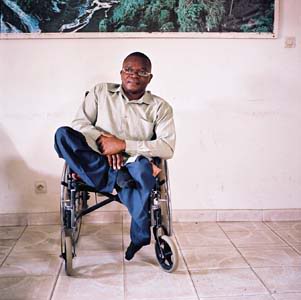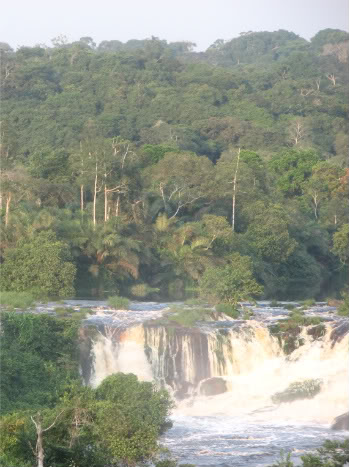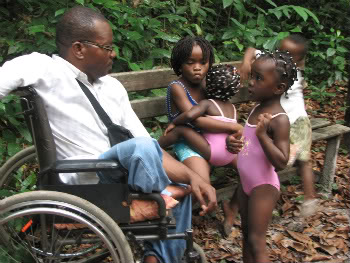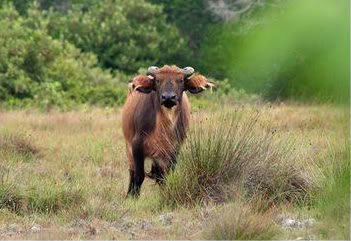Marc Ona Essangui is a beloved environmental leader in his native Gabon, however by winning the prestigious Goldman Environmental Prize he is now being introduced to a larger audience: the world.
Essangui received the prize for exposing unsavory truths about a deal between the Gabon government and a Chinese company, CMEC, to mine for iron ore in the Congo rainforest, the world’s second largest tropical forest. The Belinga mine is a $3.5 billion project that also includes a hydroelectric dam, which will flood traditional lands and destroy what is considered the most beautiful waterfall in the forests of equatorial Africa. The Kongou Falls is located in the Ivindo National Park.
In 2002 President of Gabon, Omar Bongo, was widely hailed for establishing National Parks across Gabon that incorporated 10 percent of the nation’s land. However, subsequent deals, including the Belinga mine, have troubled many for putting these vast parks and their rich biodiversity in jeopardy.
 Marc Ona Essangui. Photo by: Candace Feit. |
“Industrialization of Africa without ecological conscience will bring ruin to the African continent,” Essangui, who is in a wheelchair due to childhood polio, says in a video produced for the Goldman award. “Today Africa is still spared catastrophes like Hurricane Katrina or tsunamis because we still have the vegetation that protects us from these phenomena. If we accelerate climate change by destroying African forests, which is the second biggest forest in the world, we are headed to catastrophe.”
For years Essangui, President and founder of the local environmental organization Brainforest, called for a full environmental impact assessment of the dam, while advocating for a different site located outside the Ivindo National Park. In addition, his organization argued that the Belinga concession was far too large, measuring 7,700 square kilometers. Essangui and his organization worked tirelessly to inform local communities, who knew little of the project, about their rights.
In 2007 Essangui obtained a leaked copy of the agreement between the Gabon government and the CMEC. The agreement, which had been kept secret from the Gabonese public, showed that Gabon was getting the short end of the stick, receiving only 10 percent of profits from the mine while CMEC was granted a 25-year tax break.
 Essangui is fighting to save the Kongou Falls from being destroyed by a hydroelectric dam. Photo by: John Antonelli. |
Due to public outrage and non-stop work, Essangui and his organization have achieved considerable success related to the mine. The dam concession has been cut by nearly 90 percent. A road that the Chinese had already built through Ivindo Park has been relocated. Gabon, as well, has renegotiated the contract with the Chinese with help from the World Bank for a more equal deal, including getting rid of the tax break for CMEC. Currently, the status of the project is up in the air
“Without our intervention the Chinese would be already exploiting the mine and ignoring Gabonese law,” Essangui says in the Goldman Environmental Prize video. “Now they are trying to figure out if there is a real necessity to exploit the iron mine. I am very hopeful because the retreat of the government in this case shows that when you have the law on your side you are stronger. This is why we think we are going to win.”
Essangui has pursued his mission at considerable personal risk. Just over a year ago in March 2008, Brainforest was broken into and information related to the Belinga mine project was stolen. Three times during 2008, the federal police of Gabon refused to allow Essangui to travel outside the country. No reasons were given.
Then in December of last year, Essangui along with other civil leaders were arrested and held for five days. They were not charged initially nor were they allowed access to any legal representation. After release Essangui was charged with possessing documents that were meant to foment rebellion against the state. Essangui denies the charge. Despite his release, the charges have yet to be dropped.
“No matter how I was treated in prison, my resolve is unweakened,” Essangui says. “I think even if I had spent 10 years in there it is worthwhile to save what has to be saved.”
 Essangui and his kids. Essangui and his family have recently been evicted from their home, since their landlord felt Essangui’s activism put the property at risk. Photo by: John Antonelli. |
As apart of the prize, Essangui will be awarded $150,000. Essangui said that the money will go toward helping local forest communities.
“I wasn’t born to be rich. I couldn’t care less about being rich,” he told Reuters. “You can’t imagine the reality of people living around Gabon’s national parks. We need to put money into helping these communities regain their dignity.”
Essangui and the other winners will be honored tomorrow, Monday, April 20th, in San Francisco. Award winners will also be visiting Washington DC for another ceremony in their honor. During their tour they will meet with policy makers, environmental organizations, and the press.
 Forest buffalo in Gabon. The small nation is also home to forest elephants and lowland gorillas. Photo by: Rhett A. Butler. |
“Carrying this fight brings meaning to my life,” Essangui concludes in the video, “it is not a personal fight or a Gabonese one, but it is a global battle. This is about the future of our children…I am ready to do what I have to do.”
The Goldman Environmental Award is given annually to six recipients from around the world for grassroots environmental activism. Other award winners this year include Rizwanna Hasan from Bangladesh, an environmental lawyer who has worked to expose the environmental consequences of the ship-breaking industry; Olga Speranskaya from Russia who has spearheaded efforts to clean-up toxic chemicals from the Soviet era across Eastern Europe; Yuyun Ismawati from Indonesia who has implemented community-based initiatives across the island-nation for local environmental sustainability; Maria Gunnoe from the United State who has spent years fighting against mountain-top removal for coal; and Wanze Edwards and Hugo Jabini of Suriname who have organized local Maroon communities to stand up against logging on their traditional lands.
Related articles
Central Africa’s ‘Most Beautiful Waterfall’ to be destroyed
(11/04/2007) One of Africa’s most dramatic waterfalls will be destroyed by a hydroelectric project in Gabon, according to reports from a Gabonese NGO and the Inter Press Service (IPS).
Logging roads rapidly expanding in Congo rainforest
(06/07/2007) Logging roads are rapidly expanding in the Congo rainforest, report researchers who have constructed the first satellite-based maps of road construction in Central Africa. The authors say the work will help conservation agencies, governments, and scientists better understand how the expansion of logging is impacting the forest, its inhabitants, and global climate.
Pictures of Gabon: gorillas, rainforest and white sand beaches
(06/26/2006) Mongabay.com, a leading rainforest and environmental web site, today announced the availability of new photos from the Central African country of Gabon. Site founder Rhett A. Butler visited Loango National Park in Gabon in late May and early June.
Gabon sets aside 10 percent of country as protected parks
(09/24/2005) In a move that sets a new standard in African conservation, the nation of Gabon, which contains some of the most pristine tropical rainforests on earth, announced today that it will set aside 10 percent of its land mass for a system of national parks. Up to this point, Gabon had no national park system. The Gabonese government has been working closely with The Wildlife conservation Society (WCS) on conservation issues for the past ten years. The announcement is a major victory for Africa’s wildlife.
The Congo rain forest, an overview of a threatened ecosystem
(06/05/2005) Known as the heart of darkness by Joseph Conrad, the Congo region has long conjured up thoughts of pygmies, mythical beasts, dreadful plagues, and cannibals. It is a land made famous by the adventures of Stanley and Livingstone and known as a place of brutality and violence for its past — the days of the Arab slave and ivory trade, its long history of tribal warfare — and its present — the ethnic violence and massacres of today.







